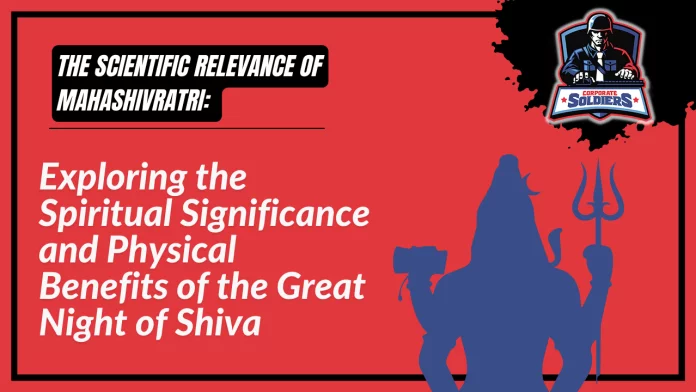Mahashivratri is a festival celebrated by Shivbhakts worldwide to honor various divine events associated with Bhagwan Shiva. The festival is celebrated on the 14th night of the new moon in the Hindu month of Phalguna, which usually falls in February or March. This year, Mahashivratri falls on February 18, 2023.
The Divine Dance of Shiva
Subheading: Shiva’s Dance of Creation, Preservation, and Destruction
Shiva is known as the God of dance, and on Mahashivratri, it is believed that he performs the Tandava, a dance that symbolizes the creation, preservation, and destruction of the universe. The Tandava is said to have been performed by Shiva to save the world from destruction.
Scientific Relevance: Dance is not only a form of expression but also has therapeutic benefits. Studies have shown that dancing can improve mood, reduce stress, and increase physical and mental well-being.
The Union of Shiva and Shakti
Subheading: The Amalgamation of Two Strong Forces in the Universe
Mahashivratri celebrates the divine union of Shiva and Shakti, two powerful forces in the universe. Shiva is known as the God of death, while Goddess Shakti represents the power that vanishes evil forces.
Scientific Relevance: The concept of two opposing forces balancing each other is prevalent in various aspects of science, such as the concept of Yin and Yang in Traditional Chinese Medicine, which emphasizes the balance of opposing forces in the body for optimal health.
Shiva’s Benevolence
Subheading: Shiva Saves the World from Destruction
During the Samudra Manthan, Halahala, a poison with the power to destroy the whole creation, emerged from the sea. Shiva drank the poison and saved the world from annihilation. Mahashivratri is observed by Shivbhakts to thank Shiva for preserving the universe.
Scientific Relevance: The concept of toxins and poisons exists in various forms in the natural world, and the ability of some organisms to adapt to such conditions and even benefit from them is a subject of study in evolutionary biology.
Celebrating the Divine Union of Shiva and Parvati
Subheading: The Day of Shiva and Parvati’s Divine Wedding
Mahashivratri is also celebrated as the day when Bhagwan Shiva and Mata Parvati got married, symbolizing the union of male and female energy in the universe.
Scientific Relevance: The concept of male and female energy and their interplay is present in many cultures and belief systems, and research has shown that the expression of gender identity affects various aspects of an individual’s life, including mental health.
Awakening of Consciousness
Subheading: Adiyogi’s Awakening at the Material Level of Existence
Mahashivratri is considered the day when Adiyogi, Bhagwan Shiva, awakened his consciousness at the material level of existence, setting in motion the process of self-realization and spiritual growth.
Scientific Relevance: The concept of consciousness and its role in the brain and behavior is a subject of study in neuroscience and psychology, with emerging research showing the potential of mindfulness practices in promoting mental health and well-being.
Mahashivratri is a celebration of the divine union of Shiva and Shakti and the many benevolent acts of Bhagwan Shiva. The festival serves as a reminder of the importance of balance and harmony in the universe, both in the physical and spiritual realms.










